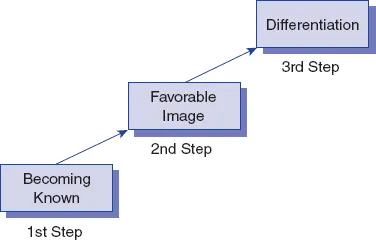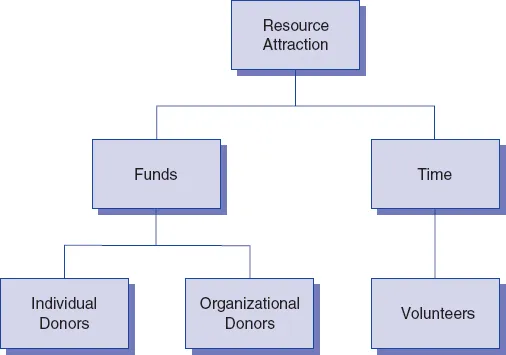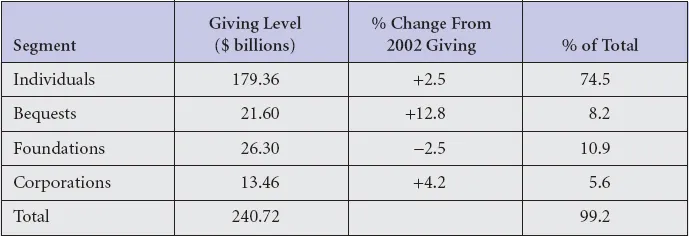
eBook - ePub
Nonprofit Marketing
Marketing Management for Charitable and Nongovernmental Organizations
Walter Wymer, Patricia A. Knowles, Roger Gomes
This is a test
Compartir libro
- 384 páginas
- English
- ePUB (apto para móviles)
- Disponible en iOS y Android
eBook - ePub
Nonprofit Marketing
Marketing Management for Charitable and Nongovernmental Organizations
Walter Wymer, Patricia A. Knowles, Roger Gomes
Detalles del libro
Vista previa del libro
Índice
Citas
Información del libro
Nonprofit Marketing: Marketing Management for Charitable and Nongovernmental Organizations is a conceptually strong text that gives students marketing strategies for nonprofit, charitable, and nongovernmental organizations, while providing them with a broad treatment of marketing basics. Written in an easy-to-follow style, marketing concepts are clearly presented and supported with real-world examples.
Preguntas frecuentes
¿Cómo cancelo mi suscripción?
¿Cómo descargo los libros?
Por el momento, todos nuestros libros ePub adaptables a dispositivos móviles se pueden descargar a través de la aplicación. La mayor parte de nuestros PDF también se puede descargar y ya estamos trabajando para que el resto también sea descargable. Obtén más información aquí.
¿En qué se diferencian los planes de precios?
Ambos planes te permiten acceder por completo a la biblioteca y a todas las funciones de Perlego. Las únicas diferencias son el precio y el período de suscripción: con el plan anual ahorrarás en torno a un 30 % en comparación con 12 meses de un plan mensual.
¿Qué es Perlego?
Somos un servicio de suscripción de libros de texto en línea que te permite acceder a toda una biblioteca en línea por menos de lo que cuesta un libro al mes. Con más de un millón de libros sobre más de 1000 categorías, ¡tenemos todo lo que necesitas! Obtén más información aquí.
¿Perlego ofrece la función de texto a voz?
Busca el símbolo de lectura en voz alta en tu próximo libro para ver si puedes escucharlo. La herramienta de lectura en voz alta lee el texto en voz alta por ti, resaltando el texto a medida que se lee. Puedes pausarla, acelerarla y ralentizarla. Obtén más información aquí.
¿Es Nonprofit Marketing un PDF/ePUB en línea?
Sí, puedes acceder a Nonprofit Marketing de Walter Wymer, Patricia A. Knowles, Roger Gomes en formato PDF o ePUB, así como a otros libros populares de Business y Marketing. Tenemos más de un millón de libros disponibles en nuestro catálogo para que explores.
Información
Part I
Marketing Management
1

Introduction to Nonprofit Marketing
Content
Opening Vignette: Ty Hafan
Dimensions of Nonprofit Marketing
Importance of Nonprofit Sector
Types of Nonprofit Organizations
Challenges Faced by the Nonprofit Sector
Adoption of Marketing Approach
Current Issues in Nonprofit Marketing
Organization of This Book
Learning Objectives
On completion of this chapter, the reader will
- Understand the definition and aims of nonprofit marketing
- Understand the variety of purposes of nonprofit marketing
- Understand the importance of the nonprofit sector to our society
- Understand the various types of nonprofit organizations
- Understand the challenges faced by the nonprofit sector
- Understand how the nonprofit sector has adopted a marketing approach
- Understand some of the emerging issues faced by nonprofit marketers
Opening Vignette: Ty Hafan
Ty Hafan, founded in 1999, is a small nonprofit organization located near the town of Barry, in Wales, United Kingdom.This nonprofit is a 10-bed children’s hospice. It offers comfort and support for dying children and bereavement counseling for family members. Its services are free. Ty Hafan’s costs are about £2 million per year. Funding is provided by charitable contributions.
Ty Hafan actively raises funds in order to cover its operating expenses. Currently, it is offering a wristband for sale (£2 each) that bears the slogan “Live the Moment.” It offers a variety of ways people who wish to support its mission can contribute or volunteer. Ty Hafan also actively uses its website to communicate with the outside world.
Like many nonprofit organizations, Ty Hafan has had to adopt a marketing approach to its administrative system. The need to build its public image, raise funds, and recruit volunteers demanded a systematic process to focus its various activities on prioritized goals.
Managers in many nonprofit organizations have adopted a marketing approach. In nonprofit organizations, marketing tactics are used to build the organization’s image and reputation in society and help the public remember the organization and its cause. Marketing tactics help differentiate one nonprofit from another nonprofit that is offering similar programs. Marketing tactics are used to attract and retain donors and volunteers.
We define nonprofit marketing as the use of marketing tactics to further the goals and objectives of nonprofit organizations. Although advertising, public relations, and fund-raising are examples of nonprofit marketing tactics, nonprofit marketing also includes a broad array of other activities. Gathering and processing information for decision making are considered components of nonprofit marketing. Relations with governments, board members, donors, and volunteers are part of nonprofit marketing.
In a broader view, nonprofit marketing is a management orientation that helps the nonprofit organization expand its horizon beyond its internal operations and programs to also encompass the external world that affects the organization. A nonprofit organization that has a marketing orientation is able to focus its various activities and external communications to project a consistent image of itself and influence the way the external world perceives it.
In this book, we use the term nonprofit organization broadly to refer to a variety of related nonbusiness and nongovernmental organizations (NGOs). As illustrated in Figure 1.1, using employment figures, we distinguish between the nonprofit, government, and business sectors of society. The relative size of each sector will vary from country to country. It is also possible to have hybrid organizations resulting from intersectoral collaborations. We will also use the term nonprofit sector to refer to that portion of a society that includes all nonprofit, charitable, and nongovernmental organizations. The nonprofit sector thus includes religious congregations, universities, hospitals, environmental groups, art museums, youth recreation associations, civil rights groups, community development organizations, labor unions, political parties, social clubs, and others (Boris and Steuerle, 1999). The nonprofit sector is sometimes called the voluntary sector, the civil society, or the independent sector in various countries.




SOURCE: Independent Sector Facts and Findings online at www.independentsector.org/PDFs/npemployment.pdf
While nonprofit organizations have different names in different parts of the world, and while they encompass many different types of these organizations, from activist groups to zoological societies, we will standardize our terminology to a degree, sometimes abbreviating nonprofit organization as NPO in this book. We may also drop organization and simply refer to a nonprofit organization as a nonprofit. These uses are all commonly accepted among nonprofit professionals.
Dimensions of Nonprofit Marketing
In the previous section, we provided an overview of the nonprofit marketing concept. In this section, we will be more specific in delineating some of the various dimensions of nonprofit marketing. We will discuss planning, positioning, communicating, and attracting resources.
Planning. Marketing professionals in nonprofit organizations, or nonprofit marketers, develop plans to help the nonprofit achieve its strategic goals; that is, to fulfill its mission.
Positioning. Nonprofit organizations usually benefit from being widely known in society. There are many nonprofit organizations and many opportunities for people to contribute to a worthy cause. A nonprofit’s first task in competing for donations is becoming well-known to the community it serves. People are bombarded with commercial marketing messages throughout the day. Nonprofit marketers must define their organizations in this clutter of information.
Once the NPO is known, the next task is to influence the public’s perception of the organization. Do people have a favorable, unfavorable, or neutral attitude toward the NPO? Do people know what the organization does? How do people think of the NPO in relation to other NPOs? Positioning refers to implementing marketing activities aimed at influencing the public’s perception of the NPO, that is, developing a specific image of the NPO in the mind of the public. Brand refers to the name, logo, and symbols that uniquely identify an NPO and distinguish it from other organizations. Figure 1.2 shows the three progressive positioning tasks for a nonprofit. The foundation begins with getting the organization known. Then the image and the public perception of the organization become a greater concern. Last, the emphasis shifts to framing how the public perceives the organization in relation to other similar organizations, the task known as differentiation.




Communication. Communication is a key marketing activity that enables the organization to achieve many of its marketing goals. The NPO directs its communications to its various stakeholders. Stakeholders are groups that have a meaningful interest in the nonprofit organization. Generally, these include the organization’s clients, board members, employees, volunteers, donors, granting organizations, government, other nonprofits, and the communities served by the NPO.
A nonprofit’s clients are the people to whom it provides services. There must be effective communication for the exchange between client and organization to be successful. Board members must be recruited and retained. Employees need to understand the NPO’s goals and objectives. They need to have a voice in the development of plans. Volunteers must be recruited and retained. Donors must be acquired and nurtured. Nonprofits often communicate with government officials to represent their causes and interests. The communities served by a nonprofit need to know about its services.
Successful nonprofit organizations establish bonds with their stakeholders and develop relationships with them. Nonprofits’ communication programs are an important resource for reaching out and maintaining contact with stakeholders.
Resource Attraction. Nonprofit marketers have a very important resource attraction function. This generally refers to attracting donations of time and funds, as depicted in Figure 1.3. Donations of time refers to the recruitment and retention of volunteers. Donations of funds refers to contributions from organizations and individuals. These contributions can be in-kind donations, such as products a company manufacturers, or monetary donations. Attracting contributions requires more discussion because it covers several topics. For example, individual donors are categorized in terms of contributed amount (large vs. regular donors), frequency (regular donors, annual campaign donors), events (special events or capital campaigns), and longevity (which includes bequest giving). Collaboration with the business sector is varied also.




Importance of Nonprofit Sector
The nonprofit sector exists to benefit society. Within the nonprofit sector, there is a rich and dynamic diversity of causes and organizations. Without the many thousands of nonprofits, with their many millions of volunteers, society would lack valuable services, diversity, and civic participation.
The nonprofit sector is important because it provides services that would not be performed by the business sector. Many services needed by a society do not generate a profit and are, therefore, unattractive to the business sector. Boys and Girls Clubs of America, for example, offers a variety of beneficial programs for youth. Examples include programs that foster conflict resolution skills, communication skills, improved homework performance, recreation and team sports, gang prevention, drug prevention, and prevention of teen pregnancy. Businesses are not interested in providing these services because, in most cases, the clients cannot afford to pay for them. Nevertheless, because nonprofits are available, these services are provided, and many individuals benefit, as well as society in general.




SOURCE: Adapted from Giving USA Foundation, 2004.
Nonprofits are important because they allow citizens to participate in their communities collectively. One of the hallmarks of a free, vibrant society is a strong nonprofit sector that activates citizen participation.
In 2002, there were about 1.8 million nonprofits in the United States (Lee, 2004). I...